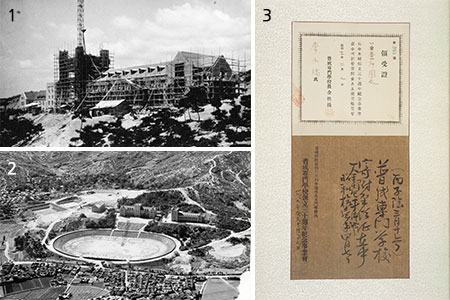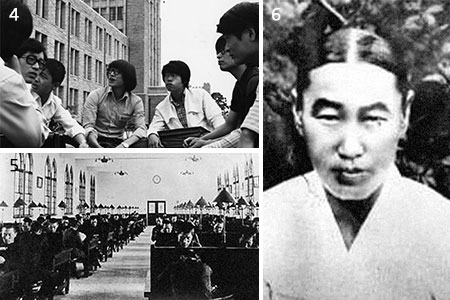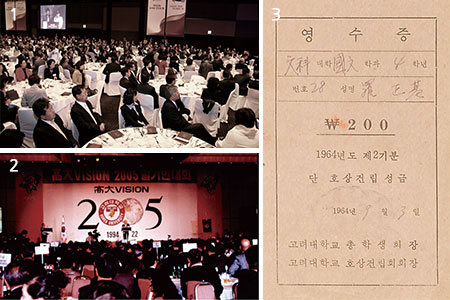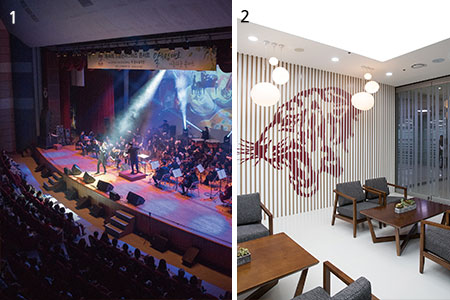[In 1930, a bold and ground-breaking fundraising campaign began.]
The 30th Anniversary Commemoration Project and the construction of the Main Library
In the 1930s, KU’s 30th anniversary commemoration project was more than just a fundraising campaign. Under the theme of “national salvation through education,” people united to become almost like a secret association. The national campaign, with the goal of collecting funds to build a school, lasted almost three years. The project was well-received by the public and led to a satisfactory outcome; similar instances are rare in the histories of the nation, of education, and of donation. The secret of the project’s success lay in concrete planning, organized campaigning, and innovative methods of fundraising. The project plan had as its goals a budget of KRW 300,000, with specific allocations such as library construction and book purchasing. Aside from the actual fundraising activities, the project plan appointed a separate group to be in charge of the project operations, the handling of donation funds, and accounting. All of these measures were a break from tradition. The way funds were raised and collected was also very innovative, and led to the project’s huge success. Realizing that word-of-mouth alone would not suffice, Inchon Kim Sung-Soo decided to use his own KRW 3,000 to buy a car (equivalent to KRW 74 million in today’s terms). Together with Kim Byeong-ro and Choi Doo-seon, he travelled all across the country to appeal for funds. Their efforts paid off. In May, 1934, KRW120,000 had been raised. By the December 1934 deadline, the total amounted to KRW 200,000.

01_The construction of Main Library was funded by an extensive donation campaign in 1935.
02_The Main Stadium was completed in 1938, a year after the completion of Main Library.
03_A list of benefactors participating in the 30th anniversary commemoration project and their donation receipts
Book donation campaign as successful as fundraising
With the funds raised, the project’s top priority of building the Main Library commenced in June of 1935 as a part of the university’s 30th anniversary celebrations. The construction costs amounted to KRW 220,000, exceeding the initial budget of KRW 170,000. On September 2, 1937, building was completed and the library opened its doors to the world. The completion of the Main Library, however, was not the end of the project, but just a beginning. Inchon Kim Sung-Soo had always believed that the value of a library should be found in its architectural design and books housed inside. He appropriated 100,000 won for book purchasing. He also conducted a campaign to encourage people to donate their family heirlooms of rare antique books. He reached out to scholars at home and abroad to send foreign books and also contacted various organizations and companies to ask for books donation. According to the Main Library’s 1938 records, 30,000 books were housed there, including 7,000 foreign books, 13,000 Korean books, and 2,419 other reference items. Those books, regarded the best collection in Korea, became a bedrock of Korea University to promote learning and scholarship. Many of those folk materials received as part of the donation campaign paved the way to open the KU Museum and Research Institute for Korean Studies.

04_Students on the lawn in front of the Seokwan in the 1970s
05_Reading rooms of the Main Library in 1937
06_Madame Ahn Ham-pyeong
Benefactors establishing a tradition of devotion and respect
From benefactors large and small living all across the country, each donation, whether money or goods, had its own story. At the end of 1934, in the middle of the fundraising campaign, Lee Won-rye living in Goheung, Jeollanam-do Province, donated KRW 500 in commemoration of her 60th birthday. The reason for her donation may have been to share her happiness with others on her special day. In another instance a Kim Shin-il’s dying wish was to bequeath her lifetime savings of KRW 500 to Korea University.
In another moving example of generosity, Ahn Ham-pyeong from Sa-cheon ri in Jeollabuk-do Province, donated fertile farmland capable of producing 700 kg of rice per year. After having run a tavern for her entire life, she had purchased the farmland with her life savings. This story has become an example of real estate donation. To pay a tribute to Madame Ahn, who passed away almost right after her donation, the university decided to spend some of the funds earned from the donated farmland on folk craft articles related to women. The farmland and its produce underwent a specially designed accounting process and were sold to be part of the seed money for the construction of KU Museum. All of these efforts to record the donation history and prepare a dedicated place to pay respect for benefactors were what made the 30th anniversary commemoration project even more special.
[1960-2010, The Tradition of Donation Becomes the Bedrock for the Next Millennium]
Seokwan (College of Liberal Arts) Clock Tower (1968)
Installed at the spire of Seokwan (College of Liberal Arts), the large clock, approximately 180 cm in diameter, can be seen from anywhere on campus. The clock was not yet installed when the building was completed in 1961. It was later donated by Kim Seong-gon, President of Ssangyong Group (’30, Department of Commerce). He commissioned the clock to artisans from Japan and the States, paying 8 million won for it.
Establishment of the Tiger Statue (1965)
The Tiger Statue is the symbol of Korea University, and embodies the youthful, passionate spirit of KU students. It was unveiled in February of 1965 with funds raised from the student population. The stone statue depicts a tiger sitting on top of the globe, delivering a message that KU students should take initiative to lead the world. At its base is inscribed the “Tiger Statue Epitaph,” an inspirational statement by poet Jo Ji-hoon.
The “Build Character through Higher Education” Campaign (1994)
Serious about it social responsibility as an educational institution, Korea University has raised its voice to emphasize the importance of humanity whenever heinous crimes have become a social issue, such as in the case of the Chijon Family gang in the 1990s. By doing so, the university has aimed to sound the alarm and take the lead in reflecting on ourselves as a people. To prepare for the upcoming 21st century, the university declared its educational reform plan, titled the “Build Character through Higher Education Campaign” in October of 1994. It hosted an academic forum welcoming anyone in Korea. As part of the campaign, it awarded “Humanity through Higher Education” prizes, hosted an event to highlight the significance of filial duty and family love, and continued its fundraising campaign. The university declared its new goal, “Vision 2005” and began preparations for its centennial celebrations.

01_Millenary KU Appreciation and Progress Night in 2010
02_Initiators’ gathering in 1994 for KU Vision 2005 ‘Build Character through Higher Education’
03_Receipt, printed in 1964, for the Tiger Statue donation
Launch of the Centennial Commemoration Project (2000)
One of KU’s sub-committee under the Centennial Committee was dedicated to fundraising. The campaign started in 2003 and was highly active in reaching out to benefactors. Some of the major fundraising activities included one to establish the Centennial Memorial Samsung Hall and the international student’s dormitory. The campaign also raised funds to enhance the educational environment, to prepare for the commemoration event, and to support globalization. Other general funds, such as scholarship funds, research funds, and culture and art funds, were also raised as part of the campaign. In 2003, the 1st Crimson Masters Concert was held to celebrate KU’s 98th anniversary, paving a way to honor its benefactors. In 2004, the university hosted the International Seoktap Festival to celebrate its centennial. The festival promoted the university’s commemoration project to alumni in the US and increased funds raised from outside the country.
The Declaration of Global Vision (2004) and the Fundraising Campaign for KU’s Centennial Celebrations (2005)
In 2004, a year before the university’s centenary, the KU Office of Development and External Affairs and the alumni association jointly hosted a ceremony to declare the university’s global vision in preparation for its centenary. There, they also initiated a fundraising campaign. The campaign was a long-term project, looking at the university’s next thousand years, and aiming for the globalization of the university. Some of the funds gathered through the large-scale campaign were used for the construction of Centennial Memorial Samsung Hall and CJ International House, a facility for foreign professors, and students.

01_ Crimson Master’s Concert invites the benefactors.
02_ KU Pride Club Lounge
KU 2030 Vision Declaration Ceremony (2008), Millenary KU Festival (2009), and Millenary KU Appreciation and Progress Night (2010)
At the KU 2030 Vision Declaration Ceremony held in 2008, the university declared its goal to enter the world’s top 100 universities by 2015 and to become one of the top 50 universities by 2030. In 2009, the university hosted the Millenary KU Festival through which it shared its development plans with students and promote the achievements that had made since its declaration in May, 2008. In 2010, the university invited approximately 600 alumni members to Millenary KU Appreciation and Progress Night. That very night, almost 400 participants agreed to donate the university, with funds totaling over KRW 20 billion.

▲KU Pride Club Scholarship Certificate Conferment Ceremony.
[2011-2018, A New Paradigm for Donation; Donation for People, Not for Infrastructure]
Benefactor-customized Service and Strengthening of Systematic Fund Raising (2011)
In 2010, Korea University adopted a benefactor-customized donation system. In the new system, benefactors can select the projects to which they wish to donate. This change transformed who could benefit from endowment funds. While the previous fundraising campaigns aimed to facilitate the construction of educational infrastructure like college buildings, the newly adopted donation system focused on programs that the university offers to students. Those programs have primarily been designed for students who want to study further or abroad. From 2011, the university published an annual report on donation funds, sharing information on where and how the funds were used. The annual reports were part of the university’s effort to sincerely communicate with benefactors about numerous changes and innovation that their donation can bring to. In 2012, the university created a Donor’s Wall to express its gratitude for benefactors. The wall consisted of name plates designed by a group of professors at School of Art and Design of the university. On the fountain-pen-shaped name plates, the names of large givers were inscribed. The fountain-pen shape of those name plates implied that the pen supported the benefactors’ beautiful decision and students devoting themselves to their studies.
Launch of the KU Pride Club; A Campaign for Regular, Small Donations to Continue the Tradition of Giving (2015)
On May 5, 2015, at its centenary, Korea University launched the KU Pride Club, introducing a new paradigm in university donation programs. The club consists of those who love Korea University, including alumni members, faculty members, and parents of students, and are willing to donate more than KRW 10,000 (equivalent to 1 account) per month. Only four months after the launch, the number of club members exceeded 1,000. As of January, 2019, the club has approximately 5,000 members. To honor their enthusiasm, the university made a special lounge for the club members in 2016. Located in the basement of the Central Plaza, the lounge, is a space of sharing designed for alumni, benefactors, and students. The funds received from the club members have been used to support students in need with KRW 200,000 per month for living expenses. The funds have been also allocated to help students study abroad. In addition, students have been able to eat breakfast for just KRW 1,000 thanks to the KU Pride Club funds.
Scholarships for Those in Need (2015)
Through its scholarship policy innovation, Korea University has promised equal opportunity to students undergoing economic hardship while fostering future intellectuals to the lead the university in a global society. In 2015, KU adopted the trend at prestigious universities, including Ivy League schools, to abolish merit scholarships. In this system, KU’s students are no longer financially rewarded only on the basis of academic achievement. Scholarship funds are instead devoted those who actually need them. Such changes to KU’s scholarship policy honor the wish of benefactors who wanted to help financially-stricken students, satisfying the original purpose of scholarship. Those policy changes also greatly affected society.

▲The name of benefactors can be searched from the Digital Donor’s Wall
Digital Donor’s Wall to Honor and Teach Sharing (2017)
The Digital Donor’s Wall, located on the basement floor at Central Plaza, was completed in November, 2017. The existing donor’s wall made with stone or metal name plates, is now digitalized and displayed on screens. The construction of the Digital Donor’s Wall was supported by Park Ki-seok (German Language and Literature, ’69), the CEO of SIGONGtech Co., Ltd. and LG Display. In 2017, the area around the wall was renamed the Crimson Honors Club and has since been developed as a state-of-the-art place for education. It aims to pay tribute to the benefactors and to deliver the message of love and sharing to all of KU’s members and visitors.

▲Kwon Oh-sub, Chairman of L&P Cosmetics Co., Ltd. at the KU Appreciation Night held in honor of the university’s 111th anniversary
Record-high Donation, KRW 11.7 Billion, Collected from 49,000 Benefactors (2017-)
For five continuous years after 2013, KU saw gradual and steady increases in promised donations. 2017 brought record amounts of promised donations and endowments, totaling KRW 11.7 billion. From 2015 to 2017, donation amounts almost doubled thanks to the benefactors who passionately supported the innovative changes made by the university. In 2016, its 111th year, the university hosted a KU Appreciation Night to show its gratitude toward the university’s generous givers. At the event, Kwon Oh-sub, Chairman of L&P Cosmetics Co., Ltd. donated KRW 12 billon for the construction of the College of Science. At the end of 2018, a married couple, Kim Young-seok and Yang Yeong-ae, decided to donate KRW 40 billion they had saved from a lifetime’s work selling fruit. The couple’s gift was a reminder of the virtue of sharing. Feeling a greater sense of responsibility than ever, Korea University has been making the utmost efforts to use the donation funds to accomplish something meaningful and valuable to everyone.



